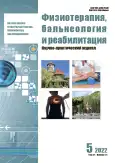Personalized physiotherapy of patients with late complications after the introduction of lip fillers
- Authors: Aksenenko I.P.1, Gerasimenko M.Y.1,2
-
Affiliations:
- Russian Medical Academy of Continuous Professional Education
- The Russian National Research Medical University named after N.I. Pirogov
- Issue: Vol 21, No 5 (2022)
- Pages: 313-320
- Section: Original studies
- URL: https://journals.rcsi.science/1681-3456/article/view/131056
- DOI: https://doi.org/10.17816/rjpbr119817
- ID: 131056
Cite item
Abstract
BACKGROUND: Lip contouring with preparations based on synthetic hyaluronic acid is one of the most popular cosmetic procedures. But in recent years, there has been an explosive increase in the number of complications. There are many physiotherapeutic methods for the treatment of late complications of lip contouring. However, currently there are no differentiated approaches to the choice of physiotherapy techniques and their combination with each other, depending on the nature of the filler and the clinical and functional picture of the complication.
AIM: to develop and evaluate the use of personalized physiotherapy in patients with complications after the introduction of lip fillers, taking into account their genetic predisposition.
MATERIAL AND METHODS: The study involved 52 patients aged 30–42 years with a diagnosis of "L57.4 Senile atrophy (lethargy) of the skin", who received late complications (local swelling, dry and pale lip skin, filler contouring, soreness, sensitivity change) at the filler injection site. All patients underwent genetic testing on the Cosmetology panel before the start of treatment. There were 3 groups that received physico-pharmacological methods: laserophoresis of longidase, diadinamophoresis of collagenase or a combination of them in the lip area at the filler injection site.
RESULTS: When analyzing the data after the course of treatment, patients with the combined protocol showed a significant improvement in the quality of life, both in the near and long-term research period. This was expressed in a statistically significant decrease in intradermal edema, rapid regression of pain syndrome and more accelerated biodegradation of the superficially injected filler in the main group compared to other study groups/
CONCLUSION: In patients with late local complications after the introduction of hyaluronic acid fillers, the combined protocol with the inclusion of laser-phoresis of longidase and collagenase diadinamophoresis significantly shortens the recovery period, contributes to a faster reduction of local edema, pain, neuropathy phenomena, accelerated biodegradation of the superficially injected filler, and also allows for a stable clinical result. Personalized physiotherapy is an effective factor in relieving complications after lip contouring.
Full Text
##article.viewOnOriginalSite##About the authors
Irina P. Aksenenko
Russian Medical Academy of Continuous Professional Education
Email: i.aksenenko@yandex.ru
ORCID iD: 0000-0003-3602-594X
SPIN-code: 8172-4573
MD, Cand. Sci. (Med.)
Russian Federation, MoscowMarina Yu. Gerasimenko
Russian Medical Academy of Continuous Professional Education; The Russian National Research Medical University named after N.I. Pirogov
Author for correspondence.
Email: mgerasimenko@list.ru
ORCID iD: 0000-0002-1741-7246
SPIN-code: 7625-6452
MD, Dr. Sci. (Med.), Professor
Russian Federation, Moscow; MoscowReferences
- Cosmetic surgery national data bank statistics. Aesthet Surg J. 2018;38(Suppl 3):1–24. doi: 10.1093/asj/sjy132
- Urdiales-Gálvez F, Delgado NE, Figueiredo V, et al. Treatment of soft tissue filler complications: Expert consensus recommendations. Aesthetic Plastic Surgery. 2018;42(2):498–510. doi: 10.1007/s00266-017-1063-0
- Lee AL, Chen YF, Yao WT, et al. Laser doppler imaging for treating vascular complications from procedures involving dermal fillers: Case series and literature review. Diagnostics. 2021;11(9):1640. doi: 10.3390/diagnostics11091640
- Novikov AG, Meshcheryakova IA. Expanded possibilities of vo lumetric correction of age-related changes with a filler with the therapeutic effect of NEAUVIA Organic STIMULATE. Injection Methods Cosmetology. 2018;(4):59–61. (In Russ).
- Zakirova GS, Gubanova EI, Gladko VV, et al. A randomized study of the safety and efficacy of drugs based on stabilized hyaluronic acid for the correction of involutional changes in the skin of the face and neck. Russ J Skin Venereal Diseases. 2018;21(1):53–60. (In Russ). doi: 10.18821/1560-9588-2018-21-1-51-53-60
- Karpova EI, Gubanova EI, Zmazova VG, Chaikovskaya EA. Undesirable phenomena and complications of injection lip plasty. In: Injection contouring. Issue 3. Moscow: Kosmetika i meditsina; 2015. Р. 412–423. (The Golden Collection series). (In Russ).
- Mingazova LR, Karpova EI, Orlova OR. Neuropathic disorders in the facial area after contour injection plastic surgery. In: Injection contouring. Issue 3. Moscow: Kosmetika i meditsina; 2015. Р. 372–378. (The Golden Collection series). (In Russ).
- Ikonnikova EV, Gensler EM. Problems of injection cosmetology: a review of complications and methods of their correction. Medical Alphabet. 2020;(6):79–82. (In Russ). doi: 10.33667/2078-5631-2020-6-79-82
- Karpova EI, Potekaev NN, Muratov SV, et al. Complications of contour injection facial plastic surgery: World and Russian experience. Plastic Sur Aesthetic Med. 2019;(4):54–75. (In Russ). doi: 10.17116/plast.hirurgia201904154
- Ranneva EA, Deprez P. Hyaluronidase in aesthetic medicine: Theoretical background and practical application experience. In: Injection contouring. Issue 3. Moscow: Kosmetika i meditsina; 2015. Р. 429–435. (The Golden Collection series). (In Russ).
- Talybova AP, Kruglova LS, Stenko AG. Ultraphonophoresis of an enzymatic preparation in the treatment of post-acne scars. Russian journal of the physial therapy, balneotherapy and rehabilitation. 2017;16(5):254–256. (In Russ). doi: 10.18821/1681-3456-2017-16-5-254-256
- Belovol AN, Tkachenko SG, Tatuzyan EG. Physiotherapy in cosmetology: Study guide manual on the elective course. Kharkiv: Kharkiv National Medical University; 2015. Р. 70–74. (In Russ).
- Nuvakhova MB. Polyneuropathy: Methods of treatment and rehabilitation. Medical sciences. Novaum.ru. 2019;(17):409–412. (In Russ).
- Kruchinskaya MG, Manturova NE. Complications in aesthetic medicine and methods of correction. Physiotherapist. 2019;(6):49–53. (In Russ). doi: 10.33920/med-14-1905-08
- Mayorova AV, Sysuev BB, Ivankova YO, Khanalieva IA. Collagenases in medical practice: Modern collagenase-based drugs and prospects for their improvement. Pharmacy Pharmacology. 2019;7(5):260–270. (In Russ). doi: 10.19163/2307-9266-2019-7-5-260-270
- Yang J. Personalized skin care service based on genomics. In: International Conference on Health Information Science. Springer, Cham; 2021. Р. 104–111.
- Morgunova MA. Genetic testing in personalized cosmetology. Cosmetics Medicine. 2018;(4):80–84. (In Russ).
- Kurganskaya IG. Personalized high-intensity laser therapy of patients with pathological skin scars. Russian journal of the physial therapy, balneotherapy and rehabilitation. 2020;19(5):278–285. (In Russ). doi: 10.17816/1681-3456-2020-19-5-1
Supplementary files







